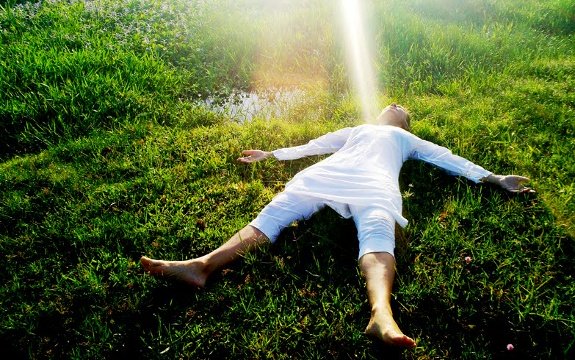The Most Important Yoga Position is the Corpse Pose (Savasana)


Hatha yoga has seen it’s share of miracle recoveries and vastly improved health. But after a series of poses or postures called asanas, the asana that appears to be the easiest is the most demanding and rewarding. It’s the corpse pose, or savasana, the last posture or asana in any Hatha Yoga routine. It’s apparently the easiest, because one lies flat on one’s back without moving, but it’s actually the most difficult to master because it’s so subtle and internal.
What It Does for You
By gradually relaxing every muscle in your body, you are slipping away from the more manic pursuits of our diseased culture. After some success with the corpse pose, you will find it easier to be calmly in a witness state, despite what is going on around you. The corpse pose aligns your subtle energy body with your physical. Without that, you won’t benefit fully from the yoga poses. The subtle body is more like your energy field or astral body. It remains even after the physical body expires. The subtle body is what you will be taking with you after physical death.
Letting Go is What It’s All About
Ultimately, your experience is the final judge of how well you do the corpse pose. You should practice on a firm surface with minimal padding to discourage napping. Lay flat on your back, legs apart slightly and arms slightly apart from your body with palms up. Palms up helps you stay awake. Avoid falling asleep. You want more conscious awareness, not less. But a mind racing or drifting is distracting. When your mind does this, bring it back gently to one of two physical areas: Focus on breathing and/or relaxing tense muscles.
Read: Five Tibetan Rites – Mind Body Healing Adds ’10 Years to Life Span’
The standard technique of releasing tension in sequence from the feet up or from the head, neck and shoulders down takes time. So you may have to be satisfied with partial relaxation sessions as you progress toward total relaxation.
As you progress, sometimes relaxed muscles tense up again. Go back to that section and continue until you feel the tension release. If the orderly sequence of conscious relaxation in different muscle sections is too difficult, then simply focus on your breathing in a relaxed manner. Allow your awareness to discover an obvious area of tension. Stay with it until it you’ve relaxed the tension completely.
Then shift your awareness to another part that is tense and work on relaxing that area. As you do this, progress is indicated by feeling that you’re wide awake while experiencing a feeling of melting into the floor with no desire to move. Eventually, you’ll realize the bliss of total mind and muscle relaxation or letting go of tension. Graphic instructions here and here.
The corpse pose can be practiced anytime without practicing other yoga postures. At first, you may feel dull and tired, or restless and wanting to move about. But these conditions resolve with patient practice. Ultimately, one can do the corpse pose to totally relax and rejuvenate in 5 to 20 minutes or so anytime, anywhere.
Additional Sources:

My way to relax and a strawberry daiquiri.
my way to relax after a couple of those =)